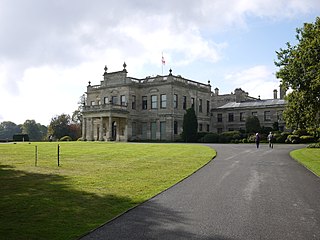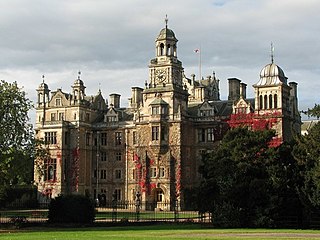
Brodsworth Hall, near Brodsworth, 5 miles (8 km) north-west of Doncaster in South Yorkshire, is one of the most complete surviving examples of a Victorian country house in England. It is virtually unchanged since the 1860s. It was designed in the Italianate style by the obscure London architect, Philip Wilkinson, then 26 years old. He was commissioned by Charles Sabine Augustus Thellusson, who inherited the estate in 1859, but the original estate was constructed in 1791 for merchant and slave owner Peter Thellusson. It is a Grade I listed building.

Colonel Sir Charles Seely, 1st Baronet KGStJ, DL was a British industrialist and politician.

John Carr (1723–1807) was a prolific English architect, best known for Buxton Crescent in Derbyshire and Harewood House in West Yorkshire. Much of his work was in the Palladian style. In his day he was considered to be the leading architect in the north of England.

Wallingwells is a small civil parish and hamlet in the Bassetlaw district of Nottinghamshire, England, with a population at the 2001 census of 22. The population remained less than 100 at the 2011 census, details were included in the civil parish of Carlton in Lindrick. The population was recorded as 27 at the 2021 census. It lies about five miles north of Worksop.

Duncombe Park is the seat of the Duncombe family who previously held the title Earls of Feversham. The title became extinct on the death of the 3rd Earl in 1963, since when the family have continued to hold the title Baron Feversham. The park is situated one mile south-west of Helmsley, North Yorkshire, England and stands in 300 acres (120 ha) of parkland. The estate has a commanding location above deeply incised meanders of the River Rye within the North York Moors National Park.

Thoresby Hall is a grade I listed 19th-century country house in Budby, Nottinghamshire, some 2 miles (4 km) north of Ollerton. It is one of four neighbouring country houses and estates in the Dukeries in north Nottinghamshire all occupied by dukes at one time during their history. The hall is constructed of rock-faced ashlar with ashlar dressings. It is built in four storeys with a square floor plan surrounding a central courtyard, nine window bays wide and eight bays deep.

Worksop Manor is a Grade I listed 18th-century country house in Bassetlaw, Nottinghamshire. It stands in one of the four contiguous estates in the Dukeries area of Nottinghamshire. Traditionally, the Lord of the Manor of Worksop may assist a British monarch at his or her coronation by providing a glove and putting it on the monarch's right hand and supporting his or her right arm. Worksop Manor was the seat of the ancient Lords of Worksop.

Charles Duncombe, 1st Baron Feversham, was a British Member of Parliament.

Serlby Hall is a grade I listed 18th century mansion and estate in Nottinghamshire, England, located 7 miles north-east of Worksop.

Stanford Hall is a grade II* listed 18th-century English country house in Nottinghamshire, England, in Stanford on Soar just north of Loughborough. It is home to the Defence and National Rehabilitation Centre (DNRC).

Middleton Hall is a restored 17th-century country house at Stoney Middleton, Derbyshire. It is a Grade II listed building.

Beamish Hall is a mid-18th-century country house, now converted to a hotel, which stands in 24 acres (97,000 m2) of grounds near the town of Stanley, County Durham. It is a Grade II* listed building.

Huntroyde Hall is a grade II listed, 16th-century house in the civil parish of Simonstone in the Borough of Ribble Valley, Lancashire, England. Its estate, Huntroyde Demesne, once extended to over 6,500 acres.
The Shafto family is an alternative surname for the Ffolliot family, who were established in the 14th century at Shafto Crag, Northumberland and adopted the alternative surname of Shafto.

Colwick Hall was an English country house in Colwick, Nottinghamshire. It is now a hotel. The building is Grade II* listed.

Duxbury Hall was a 19th-century country house in Duxbury Park estate in Duxbury Woods, Duxbury, Lancashire that has been demolished.

Winkburn Hall is a Grade I listed country house which stands at the corner of an estate a few miles north-east of Southwell, Nottinghamshire, off the Hockerton to Kirklington road. It was built for the Burnell family circa 1700 as a two-storey mansion in red brick with ashlar dressing and a hipped slate roof. The original mansard roof has since been converted to an additional third storey.
Quernmore Park Hall is a grade II* listed Georgian country house which stands in a 20-acre estate in the village of Quernmore, part of the City of Lancaster district of England.
Warner Hotels is a hospitality company owning 14 country and coastal properties around the UK in North Wales, Somerset, Herefordshire, Berkshire, North Yorkshire, Nottinghamshire, Isle of Wight, Suffolk, Hampshire and Warwickshire. Founded in 1932 as Warner Holiday Camps, later known as Warner Holidays and has been adult only since 1994. In the 1990s Warner's started developing country house hotels and changing their existing 'camps' into coastal resorts and hotels.

Millichope Park is a 19th-century country house in Munslow, Shropshire, England, some 5 miles south-east of Church Stretton.


















